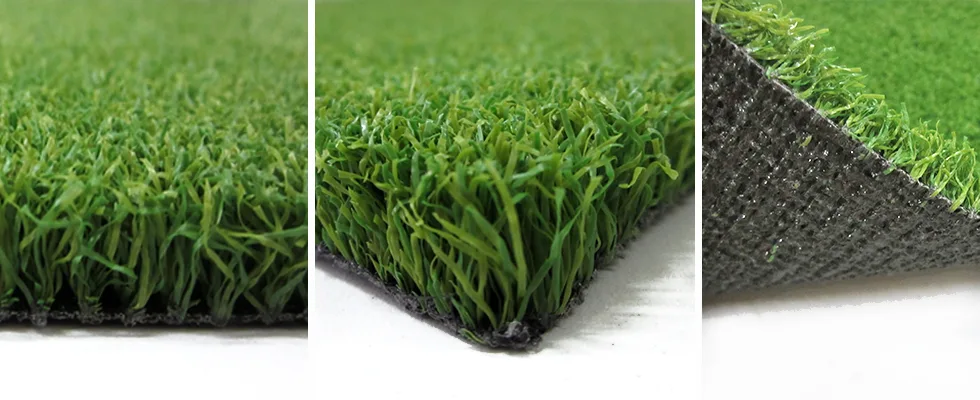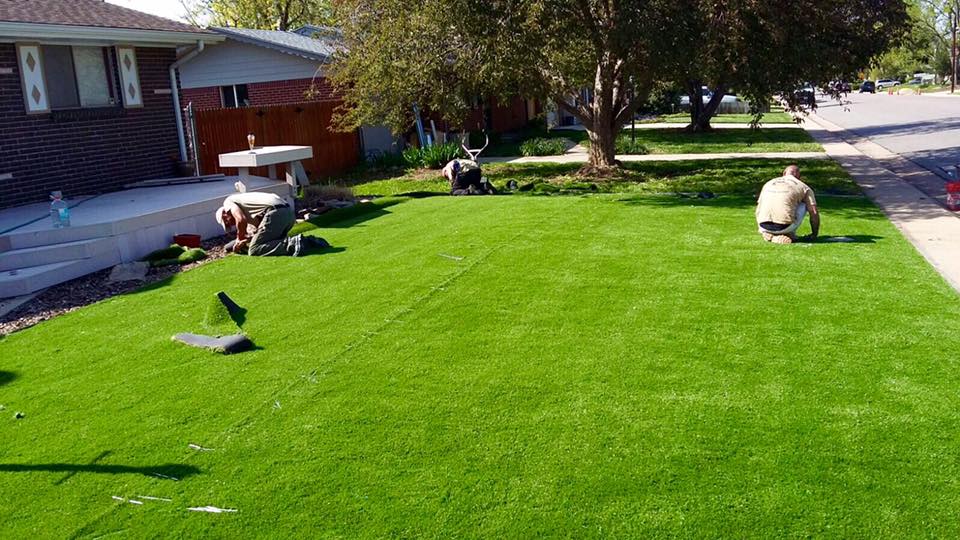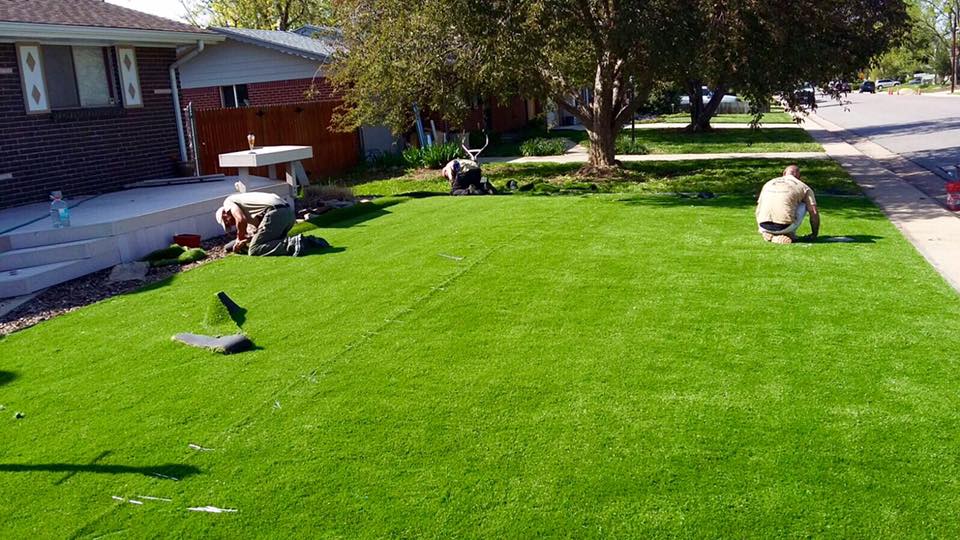Artificial grass, which is also known as synthetic turf, has become a preferred option for many homeowners because of its low maintenance requirements and evergreen appearance throughout the year.
Switch to synthetic grass to create a safe, non-toxic environment for yourself and your family to enjoy. Your pets and kids will also love your artificial grass lawn because now they can go outside and play and you don’t have to worry about them getting dirty and coming back into the house.
Most importantly, it is low maintenance thereby saving your time and money on maintenance costs. So if you are a homeowner, the elderly for whom maintenance is not practical, second/vacation home owners, and also organizations such as local councils who have to maintain road verges, city parks, and pathways, Consider installing artificial grass from Lawn Pros.
If you are thinking of installing artificial grass on the soil in your yard, this guide will walk you through the process step by step.

| Tool | Description |
|---|---|
| Turf Cutter or Utility Knife | Used to cut and shape the artificial grass to fit the installation area. |
| Shovel or Excavator | To remove existing turf, soil, or debris and prepare the ground. |
| Wheelbarrow or Bucket | For transporting base materials like crushed stone or sand. |
| Rake or Hoe | To level and smooth the prepared ground before installing the turf. |
| Plate Compactor or Tamper | Compacts the base materials for stability and evenness. |
| Measuring Tape | Measures the area accurately for proper sizing of the artificial grass. |
| Stakes and String | Used to create guidelines and borders for accurate installation. |
| Landscaping Fabric/Weed Membrane | Prevents weed growth and enhances drainage beneath the artificial grass. |
| Crushed Stone or Aggregate Base | Provides a stable and well-draining foundation for the artificial grass. |
| Jointing Tape and Adhesive | Binds seams together for a seamless look and prevents shifting. |
| Galvanized Nails or Staples | Secures the artificial grass to the base material and prevents shifting. |
| Broom or Power Brush | Brushes the grass fibers against the grain to achieve a natural look. |
| Silica Sand or Infill Material | Fills the spaces between grass blades for added stability and support. |
| Gloves and Knee Pads | Protects hands and knees during the installation process. |
Preparing the Ground
Before you begin the installation process, it is crucial to prepare the ground properly to ensure a long-lasting and seamless finish. Follow these steps to get the ground ready for the artificial grass:
Clear the Area: Start by removing any existing grass, weeds, rocks, or debris from the soil. This will provide a clean and even surface for the artificial grass to be laid on.
Level the Soil: Use a shovel, rake, and compactor to level the soil and create a smooth base for the artificial grass. Make sure to eliminate any bumps or low spots to avoid an uneven final result.
Install Edging: To prevent the artificial grass from shifting, install edging around the perimeter of the area. This can be done using flexible steel or plastic edging secured into the ground.
Add a Weed Barrier: To prevent weeds from growing through the artificial grass, lay down a weed barrier fabric over the soil. This will help maintain the integrity of the installation over time.

Installing the Artificial Grass
Once the ground has been properly prepared, you can move on to installing the artificial grass. Follow these steps for a successful installation:
Step 1: Measure and Cut the Grass
Measure the Area: Use a tape measure to determine the dimensions of the area where you will be laying the artificial grass. Be sure to account for any curves or irregular shapes.
Cut the Grass: Once you have your measurements, roll out the artificial grass and cut it to fit the area. Use a utility knife to make precise cuts, ensuring a perfect fit.
Step 2: Lay the Grass
Position the Grass: Roll out the artificial grass over the prepared soil, making sure the blades are facing the desired direction. Allow the grass to acclimate to the temperature and shape of the ground for a few hours.
Trim Excess Edges: Trim any excess grass using a utility knife to achieve a clean and polished look. Make sure to leave a small gap between the edges of the grass and any surrounding surfaces for expansion.
Step 3: Secure the Grass
Use Adhesive: Apply adhesive to the edges of the artificial grass strips and press them firmly together. Make sure to follow the manufacturer’s instructions for the specific adhesive used.
Secure with Nails: To further secure the artificial grass, use galvanized nails along the perimeter and seams. Make sure to space the nails evenly to prevent any buckling or shifting.
Step 4: Infill the Grass
Apply Infill: Spread a layer of infill material over the artificial grass to provide stability, support, and a more natural look. Use a stiff broom to evenly distribute the infill throughout the grass fibers.
Brush the Grass: To enhance the appearance and durability of the artificial grass, brush the fibers using a stiff broom or brush. This will help the blades stand upright and improve the overall aesthetic.

Maintenance and Care
After installing artificial grass on soil, it is essential to properly maintain and care for it to ensure longevity and optimal performance. Follow these tips to keep your artificial grass looking great:
- Regularly remove debris and leaves from the surface of the artificial grass to prevent mold and mildew growth.
- Rinse the grass with water occasionally to remove dust and dirt buildup. Use a mild detergent for tougher stains if needed.
- Brush the grass fibers regularly to keep them standing upright and looking fresh. This will also help prevent matting and compacting over time.
- Avoid using sharp objects or chemicals on the artificial grass as they can damage the fibers and affect the overall appearance.
| Remember that proper maintenance is key to the longevity and appearance of your artificial grass. By following these simple tips, you can enjoy a lush green lawn all year round. |
Benefits of Artificial Synthetic Grass
Lawn Pros Artificial Synthetic Grass provides you with a beautiful, lush, natural-looking lawn year-round with zero lawn maintenance.
Plus, it’s eco-friendly and made in the USA. By switching to artificial lawns, you can reduce your monthly water bills by up to 70 percent and reduce your carbon footprint.
Artificial turf also does not require any fertilizers, herbicides, or pesticides. These chemicals not only add to the toxins in the environment, but many people also have mild to severe reactions to them, including itchy and watery eyes, itchy throat, and runny nose.
Conclusion
Installing artificial grass on soil can be a rewarding project that transforms your outdoor space into a low-maintenance oasis.
By following the steps outlined in this comprehensive guide, you can achieve a professional-looking finish that will last for years to come.
From preparing the ground to laying the grass and maintaining it properly, each step plays a crucial role in the overall success of the installation. So, roll up your sleeves, get your tools ready, and start creating a beautiful artificial grass lawn today!
FAQs
Can I just lay artificial grass on soil?
- While it’s possible to lay artificial grass directly on the soil, it’s generally recommended to install a base for better stability and drainage. Adding a base helps prevent the grass from settling and provides a more even surface.
How do you pin artificial grass to the soil?
- To secure artificial grass to soil:
- Use galvanized nails or staples designed for artificial turf.
- Space the pins around 6 to 8 inches apart along the edges and seams.
- Drive the pins into the soil, ensuring they go through both the grass and the base underneath.
What do you put under artificial grass?
- Under artificial grass, a common installation includes a base composed of crushed stone, decomposed granite, or specialized base material. This provides a stable foundation, aids in drainage, and helps prevent the synthetic turf from shifting or settling. Additionally, a weed membrane may be used to prevent weed growth.

